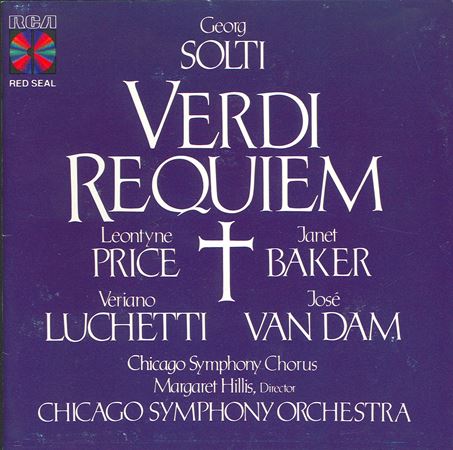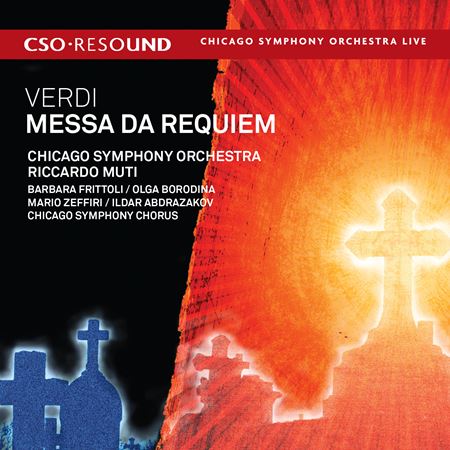Early edition piano/vocal score for Verdi's Requiem
Theodore Thomas collection
There is no evidence that Theodore Thomas, our founder and first music director, conducted Verdi’s Requiem with the Chicago Orchestra. Prior to the Orchestra’s founding in 1891, there is documentation that he first led the Requiem on May 1, 1884, with his eponymous ensemble — the Theodore Thomas Orchestra — and the Oratorio Society of Baltimore, given at the Fifth Regiment Armory in Baltimore, Maryland. His last known performance of the work was on May 24, 1890, at the Cincinnati May Festival, which he had founded in 1873.
According to Thomas’s music catalog (held at the Newberry Library), there were two orchestral scores and a set of manuscript parts of the Requiem in his collection. One manuscript score (in an unknown hand) was deposited at the Newberry by Thomas’s widow Rose Fay in 1905; the second score is presumed lost. In the Rosenthal Archives, we have the set of parts, some printed with manuscript inserts and some completely in manuscript. We also have an early edition of a piano/vocal score (not included in the catalog), later recovered from materials left at Thomas’ summer home in New Hampshire.
All of the orchestral parts are wrapped with covers stamped by Ricordi and bearing the signature of Maurice Strakosch, who purchased an orchestral score and performance material from Casa Ricordi in November 1874, just a few months after the composer led the premiere in Milan on May 22. The U.S. premiere of Verdi’s Requiem was given on May 5, 1878, in Boston by the Handel and Haydn Society, and this set of parts was likely used for that performance.
Maurice Strakosch was an American pianist and impresario of Bohemian descent. He studied with Simon Sechter at the Vienna Conservatory, toured Europe as a pianist and landed in New York City in 1848. Strakosch played concerts there under the management of Max Maretzek, but by 1856, he was active mainly as an impresario. He became associated with tenor Salvatore Patti and his daughters — Adelina, Amalia and Carlotta, all singers — in New York, later marrying Amalia. He also coached Adelina from her concert debut at the age of eight in 1851 and later managed her career, as she became one of the most famous singers of the day.
From 1852 until 1854 Strakosch toured the United States with Amalia, Adelina, violinist Ole Bull, and Theodore Thomas, then a teenaged violinist. Strakosch eventually managed his own company from 1856, which soon merged with that of Bernard Ullman‘s in 1857 to form the Ullman-Strakosch Opera Company (for which Thomas was concertmaster and occasionally conductor), later absorbed by the New York Academy of Music.




In 1990 the University of Chicago Press issued a critical edition of Verdi’s Requiem, the one currently used by the Chicago Symphony Orchestra and Chorus. The 1874 set of parts was referenced in the preparation of that edition, and in the volume’s preface, it reads that the set of parts was “the earliest and most authoritative source to help resolve ambiguities” in the orchestration. These parts
. . . were clearly prepared before 1875, as they include the original “Liber scriptus” (1874). Most also have as a later insert (of uncertain date) the definitive “Liber scriptus” (1875): these inserted pages are written on paper produced by the New York firm of Carl Fischer. As noted in the introduction to the score, on 9 November 1874, Ricordi informed Verdi that performing materials had been sold to one of the Strakosch brothers. . . . How they found their way into the Chicago Symphony Orchestra collection has not been determined, although it is possible that they belonged to the musical library of Theodore Thomas. . . . From players’ annotations, however, it is apparent that these parts were used for performances even after Ricordi issued printed parts in 1913.
This set of manuscript parts was most likely used for the Chicago Symphony Orchestra’s first documented performance of the Requiem given at Northwestern University Gymnasium on June 4, 1910, as part of the annual North Shore Festival, as well as numerous subsequent occasions, including the first performance at the Ravinia Festival in 1951 and the first subscription concerts at Orchestra Hall in 1952. One of those annotations confirms this: when details for this set of parts was being entered into the Rosenthal Archives’ database, the cataloger indicated: “squashed bug removed from 3rd trombone part, noted as killed at Ravinia, 1951.” Also, the first trumpet illustrated his preferred intermission activity at the end of the “Dies irae”: a smoking pipe.






Chicago Symphony Chorus history buffs might remember that Verdi’s Requiem was the impetus for the founding of the ensemble at the request of sixth music director Fritz Reiner. In 1957 he invited Margaret Hillis to establish a chorus, and the ensemble made its debut in March and April 1958, in Mozart’s Requiem under Bruno Walter and Verdi’s Requiem under Reiner. By then, the Orchestra was using a new set of engraved parts published by C.F. Peters.
The Orchestra and Chorus has performed Verdi’s Requiem on dozens of occasions since then in Orchestra Hall and Carnegie Hall and at the Ravinia Festival. The Orchestra and Chorus recorded the Requiem under music directors Sir Georg Solti and Daniel Barenboim, and on both occasions the Chorus was prepared by Hillis. The 1977 recording won the Grammy Award for Best Choral Performance, the first of nine awards the ensemble would receive under Hillis’ direction.
And in January 2009 Verdi’s Requiem was led by Riccardo Muti in his first concerts as music director designate. The Chorus was prepared by Duain Wolfe, and the subsequent release on CSO Resound won Grammy awards for Best Classical Album and Best Choral Performance. Muti also led the Requiem to celebrate Verdi’s 200th birthday anniversary in October 2013, and that concert was simulcast into Millennium Park and on the internet. In Chicago Muti led the Requiem most recently in November 2018, and the Chorus again was prepared by Wolfe.






This article also appears here.



